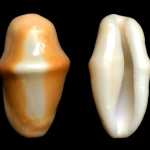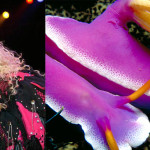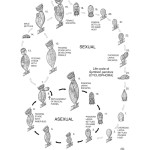An occasional series where we briefly report 3 new studies and tell you why they are cool!
Olu et al. in PLoS One examine the potential exchanges of species in cold methane seeps across the Atlantic Ocean from the Congo to the Gulf of Mexico. By culling data from the literature, the authors demonstrate, despite great distance, seeps across the ocean can share up to 30% of their species. What is the best predictor of the species composition of seeps? Depth.
Why is this study bad ass? One, biogeographic studies focused on the deep sea are rare, like logic within the Tea Party. Second, the results are so counterintuitive. Depth is the greatest predictor of composition of non-seep and non-vent deep-sea communities. This is thought to primarily reflect the reduction of food availability, i.e. carbon flux from the ocean surface, with increasing depth. But vents and seeps are decoupled from this process. Food there is generated in situ. But not all seep constituents are endemic to the seep. Transients and drifters abound and potentially cueing to gradients in food. Or maybe differences in predation with depth or physiological limits or….Third, that great distances have little meaning to many deep-sea species continues to blow my mind. In the deep-sea often the first rule of geography doesn’t apply.
Olu, K., Cordes, E., Fisher, C., Brooks, J., Sibuet, M., & Desbruyères, D. (2010). Biogeography and Potential Exchanges Among the Atlantic Equatorial Belt Cold-Seep Faunas PLoS ONE, 5 (8) DOI: 10.1371/journal.pone.0011967
Miljutin describes two new species of deep-sea parasitic nematodes, Trophomera americana and Trophomera longiovaris. Juveniles parasitize a deep-sea invertebrate. Lacking guts, the young nematodes absorb all their nutrients through the skin. However, as they absorb to their stomachs content (strike that they don’t have stomachs!) a little food is tucked away in special organ for later. Much, much later. Finally, when the host dies because they have this growing parasite in them stealing all their damn food, the nematode becomes a free living adult, doing nothing but reproducing. All sex… all the time. Thanks to all that food they saved they don’t even need to waste time eating.
Why this species description is bad ass? DEEP-SEA PARASITIC ROUND WORMS THAT ARE TOO BUSY GETTING IT ON TO FEED SO THEY EVOLVED A SPECIAL ORGAN TO STORE FOOD!
Miljutin, D. (2010). Deep-sea parasitic nematodes of the genus Trophomera Rubtsov et Platonova, 1974 (Benthimermithidae) from the Equatorial Atlantic, with the descriptions of two new species Helgoland Marine Research DOI: 10.1007/s10152-010-0225-0
I recently saw Kenneth Lohman deliver a talk to a local dive club. For an hour I was entranced by Ken’s narrative on how molluscs, lobsters, and marine turtles navigate. His group’s elegant and creative experiments have revealed much about these organisms’ internal GPS. How do they do it? By detecting the Earth’s magnetic field which varies geographically and can provide directional information. In fact marine turtles and lobsters remember the magnetic field of their home. Transplant one to another location and it will find its way back.
Why this review paper is bad ass? Older turtles, as well as spiny lobsters, apparently acquire a ‘‘magnetic map’’ that enables them to use magnetic topography to determine their position relative to specific goals. Currently, the bloggers here at DSN, i.e. the Deeplings, are building a huge electromagnet to steer tasty lobsters to our kitchens.
Cain, S. (2005). Magnetic Orientation and Navigation in Marine Turtles, Lobsters, and Molluscs: Concepts and Conundrums Integrative and Comparative Biology, 45 (3), 539-546 DOI: 10.1093/icb/45.3.539
Share the post "Tide Pool: Cool Seeps, Parasitic Nematodes, and Magnetic Sea Animals"






2 Replies to “Tide Pool: Cool Seeps, Parasitic Nematodes, and Magnetic Sea Animals”
Comments are closed.